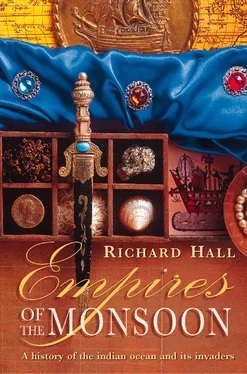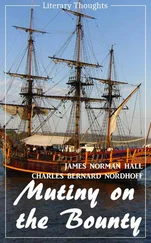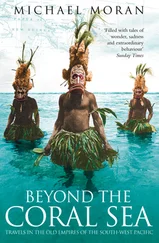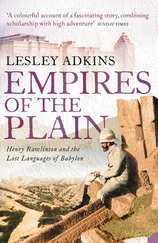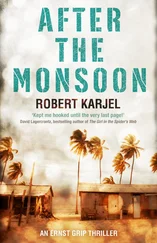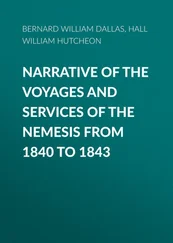1 ...6 7 8 10 11 12 ...41 The Waqwaqs’ original landfall was almost certainly the African mainland, rather than Madagascar. They were eventually driven out by the local inhabitants, but left on the coast as reminders of their stay some Indonesian words and maritime techniques, such as outriggers to stabilize canoes. The intrepid newcomers set off again, travelling south for another 1,000 miles before sighting Madagascar. This time, there was nobody to challenge them: it was a long journey’s end. In many places they found the coastline hostile, with sand bars or coral barriers, and parts of the island were dry and infertile; but there were also rich volcanic soils.
Most of the Indonesian boats were probably small and simple – little more than canoes, each carrying five or six men and women – with square sails and the outriggers to help them keep upright during storms. These small vessels may, however, have acted as escorts to larger ships, called kunlun bo by the Chinese. (The ancestors of the Maoris were to migrate to New Zealand in such vessels.) A Chinese account from the third century A.D. claims that these boats, which were also used to take Buddhist pilgrims from Sumatra to India, were large enough to carry hundreds of people and heavy cargoes. They had four sails, so skilfully rigged that the ships could set their course ‘without avoiding strong winds and dashing waves, by the aid of which they can make great speed’. 2
The Indonesian fleets undoubtedly travelled fast: from Sumatra, their most likely starting-point, it would have taken little more than a month to Madagascar in the May – October period, when the equatorial trade winds blow towards Africa. The strong east–west Malabar current would also have helped the travellers, carrying them first towards the 1,100 Maldive islands or, on the most direct route, to an uninhabited scattering of fifty coral atolls now called the Chagos archipelago, exactly halfway between Sumatra and Madagascar. Together these two island chains extend more than 1,500 miles from north to south.
The Indonesian voyagers would have found drinking water, to replenish their supplies, by digging shallow trenches on the islands. On beaches lined with coconut palms, takamaka trees, and other Asiatic plants – progeny of seeds borne for vast distances on the ocean current – they could mend the hulls and sails of their boats. When they set off again, out of the lagoons and through the reefs surrounding these lonely islands, navigating was simple: the rising sun was always on their backs, the setting sun in their eyes.
There were other places to pause and hunt for food on this bold journey, for the Indian Ocean is dotted with coral atolls, specks of greenery in an amaranthine sea. Most have never been inhabited by humans, but are alive with animals. Turtles drag themselves on land to breed and giant tortoises march ponderously through the undergrowth. The brightly-coloured birds, unused to being hunted, could also be caught for the pot.
For their great trans-ocean venture the Waqwaqs had unique advantages. They were islanders, seafarers from childhood, and their needs afloat were few. Many Pacific islands were to be populated by similar long-distance voyages into the unknown. The boats carried baskets of rice, dried fruits wrapped in banana leaves, animal skins to hold drinking water, spears and lines for fishing, and live chickens for slaughtering en route . Rice was essential for survival on such voyages, because it did not go rotten; and if food ran out, aromatic leaves were chewed to fend off hunger-pangs. 3How many of the migrants died on their way can not even be guessed at.
At the time when the first Indonesians set off across the Indian Ocean they lacked a written language, so there is no record of why or precisely when their great journeys were undertaken. They appear to have spoken a tongue now long forgotten in Indonesia, known as Old Javanese; it is likened to the language of the Batak people of northern Sumatra. 4Some of Madagascar’s religious rituals still retain vestiges of Hinduism, so it is likely that there were later migrations, over several centuries, by communities escaping from wars between rival Indonesian states.
The Indonesians who settled later in Madagascar – some after A.D. 1000 – probably did so because they discovered that people with origins like their own had survived and settled peacefully in a new island home. Such information may have come from China, that great storehouse of knowledge. References to the western flank of the Indian Ocean occur at various places in the records of the Tang dynasty (A.D. 619–906); in 863 the scholar Duan Chengshi was able to describe the Somali people. They were, he said, feuding pastoralists, living on a diet of blood and milk and ‘drawing fresh blood from the veins of their cattle with a needle’. This was an exact description of the habits of the Galla (or Oromo), who inhabited the Somali hinterland at that time. Duan went on to say that the women were ‘clear-skinned and well-behaved’; the people of Africa did not hesitate to ‘make their own countrymen prisoners and sell them to foreigners at prices many times more than they would fetch at home’. The Spanish-born historian Ibn Sa’id, who worked in the thirteenth century for the Mongol warlord Hulagu Khan, knew of Madagascar; he had been told that some Khmer people, driven by the Chinese out of what became Cambodia, managed to find their way to the island.
However, what the faraway Chinese knew could only have been a fraction of the information available in countries to which the Indonesians had sailed for centuries. In India there must have been an awareness of the existence of Madagascar, which the Arabs called al-Qumr. Indian merchants dealt directly with the African mainland, and the glass beads they used for barter can be found in the sites of Zimbabwean villages, among debris dating to A.D. 500. By this date there was a flow of ivory to India, whose own elephants were too valuable to slaughter for their tusks, since they could be tamed and used for work and warfare. African ivory was also more desirable, since the tusks were larger and softer for carving. The herds were so vast that they could be hunted virtually on the seashore.
The Waqwaqs on Madagascar were well placed to compete with Arab traders for the ivory of the mainland, and for its gold. The gold-bearing veins were reached by sinking deep trenches and shafts. The rock was made hot by lighting fires beneath it, then cracked from the top by flinging on cold water. Children carried the baskets of ore to the surface, because they could squeeze more easily through the narrow spaces in the workings. The rock was then ground and washed to extract the metal.
However, the Africans cared little for gold themselves, and the fine dust was poured into porcupine quills for safe-keeping before it was carried down to the coast. As contact with the outside world grew, the African rulers took control, distributing Indian cloth and beads to their subjects as rewards for bringing them gold-dust and elephant tusks, which were passed to the waiting traders.
The Waqwaqs were disliked by other merchants in East Africa. The Arabs resented their piratical ways, while respecting their seamanship. These rivals from the ‘Zabaj islands’ were reputed to have among them ‘men who look like Turks’; they may have been mercenaries from countries close to China, or the Khmer (Qumr) driven from Cambodia.
In A.D. 945 an armada of Waqwaq ships appeared off the East African coast and besieged the town of Qanbalu, on the island of Pemba. Before the newcomers’ warlike aims became clear, the townspeople had asked them what they wanted. The reply was frank: they were after ‘ivory, tortoiseshell, panther-skins and ambergris’ – trade goods needed in their own homeland, and in China. More than that, they wanted to capture Zanj people, ‘for they were strong and easily endured slavery’. By their own admission, the besiegers had been raiding towns and villages up and down the African coast. They were less successful when they tried to subdue Qanbalu, because it was heavily fortified; in the end they were repulsed and sailed away.
Читать дальше
